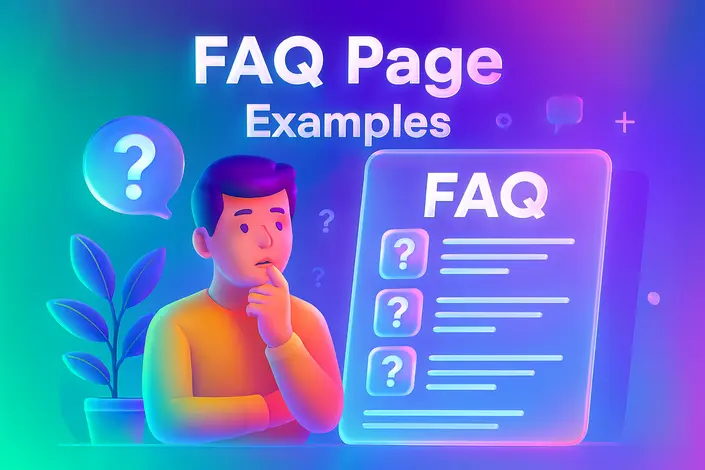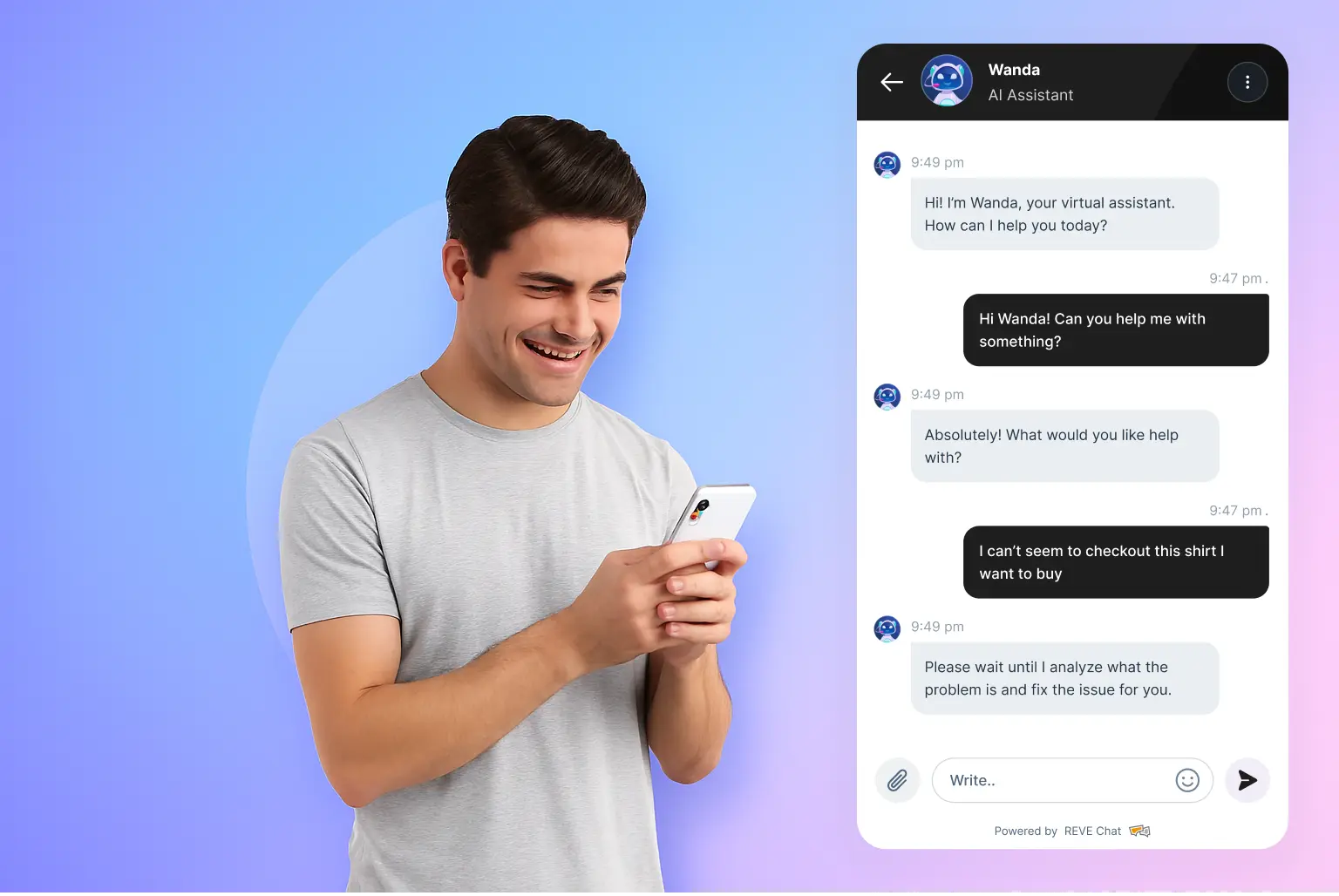Multilingual Chatbot: Benefits, Examples & How to Build
- November 20, 2024
- 11 mins read
- Listen
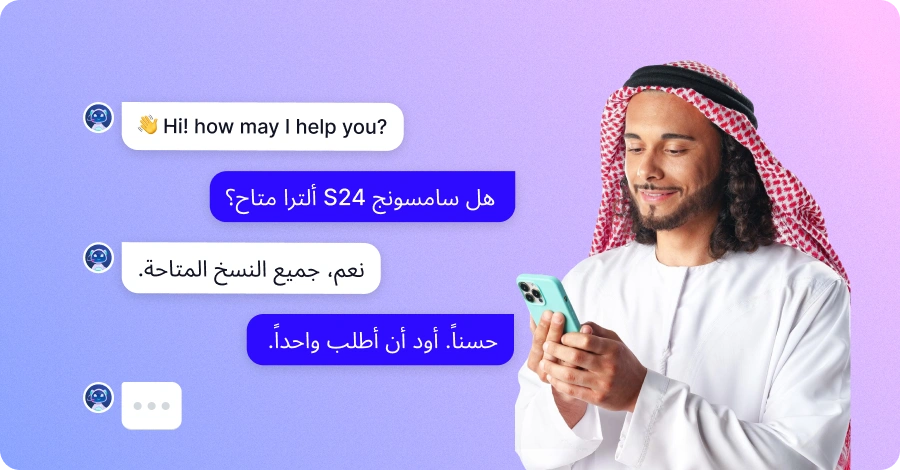
Language barriers can feel like a roadblock in today’s world of business. Whether you’re a customer support manager trying to help non-native speakers or an e-commerce owner losing sales due to miscommunication, the struggle is real.
Hiring multilingual staff? Expensive. Managing consistent service across languages? Tough. A multilingual chatbot can be the ultimate solution for reaching out to your targeted audience across the globe.
A study says, “76% of online customers prefer buying from websites in their native language, even if the language options are limited, and 40% will not make a purchase from a site in another language”
In this blog, we are going to explore how multilingual chatbots work, the best practices to implement them effectively, and real-world use cases that showcase their impact.
What is a Multilingual Chatbot in the First Place?
A multilingual chatbot is a tool designed to communicate with users in multiple languages. It automatically detects and responds in customers’ preferred language to enhance customer experience and engagement.
It leverages natural language processing (NLP) and translation capabilities to engage users in their preferred languages, catering to a global and multilingual user base.
Why Does Your Business Need a Multilingual Chatbot?
Your business needs a multilingual chatbot because it helps your business overcome language barriers. And it can be the ultimate solution to your localization problems. If your chatbot is powered by AI that would be more effective. Now let’s see the reasons for choosing a multilingual chatbot for your business:
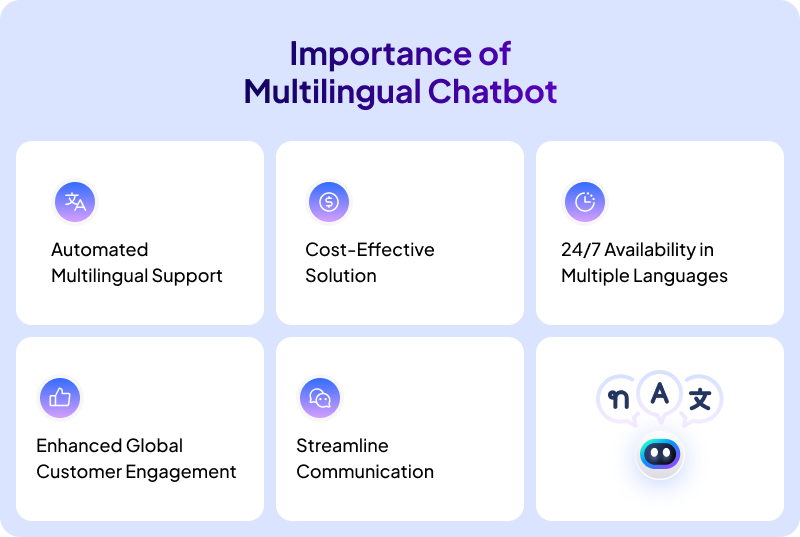
1. Automated Multilingual Support
First and foremost, think about all the inquiries your business receives daily in multiple languages. Now, imagine a solution that lets you respond to every customer. It supports their preferred language, and you don’t need a massive team of agents to make it happen. A multilingual chatbot makes this possible.
It supports languages like English, Spanish, French, and even regional ones. This ensures smooth communication with fast, accurate responses. Your customers get help quicker in their language, and your team can focus on more important tasks.
2. Cost-Effective Solution
Hiring and training multilingual staff can be expensive. And it’s not always scalable as your business grows. A multilingual chatbot solves this problem by automating customer support in different languages.
You’re not just saving money; you’re also maintaining the quality of your service. This matters most when building trust with customers.
3. 24/7 Availability in Multiple Languages
Your customers don’t stop needing help when the office closes. A multilingual chatbot ensures they don’t have to wait for working hours. Whether it’s 3 a.m. in Tokyo or 5 p.m. in New York, it’s ready to assist in their language.
This level of availability improves customer satisfaction and shows you care about their convenience.
4. Enhanced Global Customer Engagement
You can reach a broader audience by breaking down language barriers. A multilingual chatbot helps you truly connect with your audience. People feel valued when they’re addressed in their own language.
Multilingual chatbots increase customer engagement and boost conversions in international markets. It also improves customer satisfaction.
5. Streamline Communication
Relying on multilingual agents can get tricky. Even if they’re fluent, it’s hard to guarantee the same level of support across different languages. Misinterpretations happen, and that can lead to confusion for your customers.
This is where a multilingual chatbot stands out. It provides consistent, reliable answers every time, no matter the language. There’s no guesswork, no variation. It just provides clear, accurate communication.
How Does a Multilingual Chatbot Work?
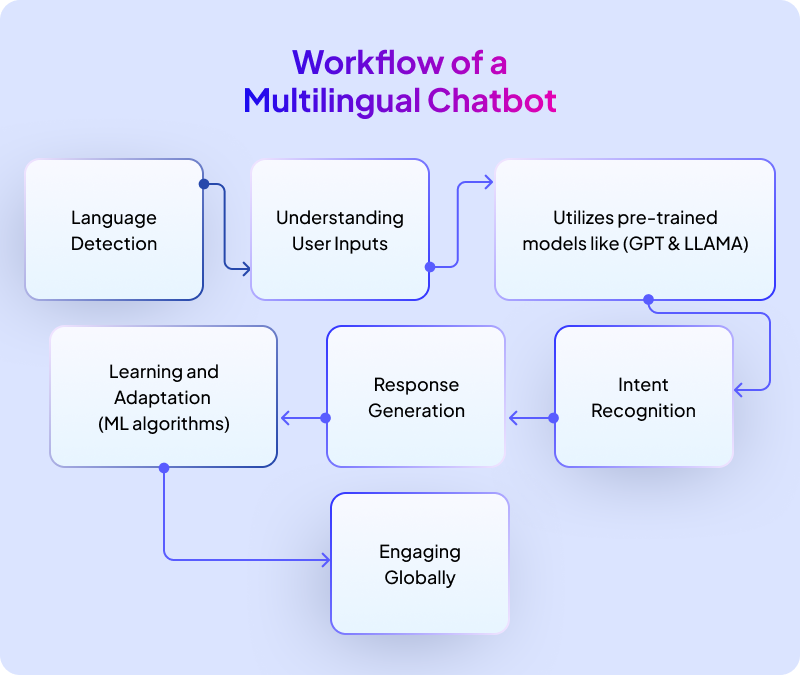
A multilingual chatbot uses advanced AI technologies, including Natural Language Processing (NLP) and Machine Learning (ML), to communicate seamlessly across multiple languages.
It begins by detecting the user’s language through NLP algorithms, which analyzes linguistic features using probabilistic models, n-grams, or neural embeddings. These techniques enable the differentiation of similar languages, such as Spanish and Italian, based on contextual and morphological cues.
Once the language is identified, the chatbot dynamically adjusts its processing to provide personalized interactions using a Large Language Model (LLM).
LLMs like GPT (Generative Pre-trained Transformer) ensure conversational fluency with context-aware responses, while LLAMA, as an open-source model, allows businesses to fine-tune it with proprietary datasets, ensuring compliance with data security and privacy standards.
For translation, APIs like Google Translate or Microsoft Translator utilize neural machine translation (NMT) models to deliver real-time, contextually accurate translations.
A centralized intent recognition system normalizes inputs across languages, mapping them to predefined intents using vector embeddings, enabling consistent response localization and workflow execution.
Additionally, ML algorithms, incorporating feedback loops, continuously learn from interactions, adapting to slang, cultural nuances, and user preferences. This ensures the chatbot evolves to meet user needs effectively, making it an essential tool for businesses engaging with a diverse, global audience.
How to Build a Multilingual Chatbot: Step-by-step Guide
There are several ways to create a multilingual chatbot, depending on the platform and its purpose. In this blog, we’ll use REVE Chat as an example to guide you through building your own multilingual chatbot. To enable multilingual support for your chatbot, follow the below process-
Step 01: First log in to your REVE Chat account. if you don’t have an account yet, you can sign up by going here.
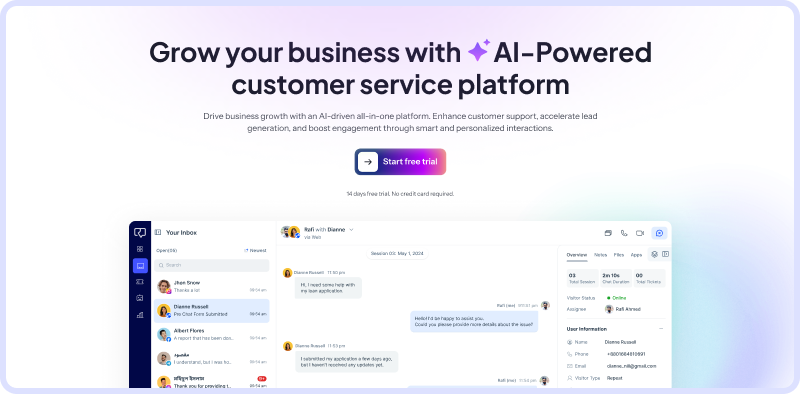
Step 02: Go to the chatbot menu and in the top right corner you will get an option to create a chatbot.
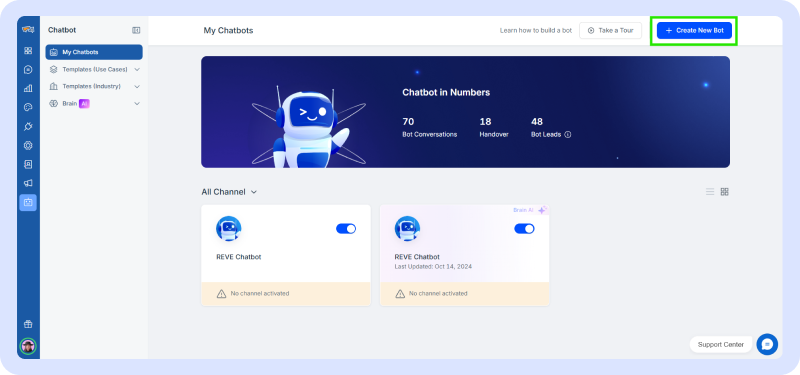
Step 03: You will get one pop up where you need to fill up the details of your chat. There is a dropdown where you can select your default language. This default language will indicate the language in which you will build the chatbot. Later you can translate it in other languages which we will cover later.
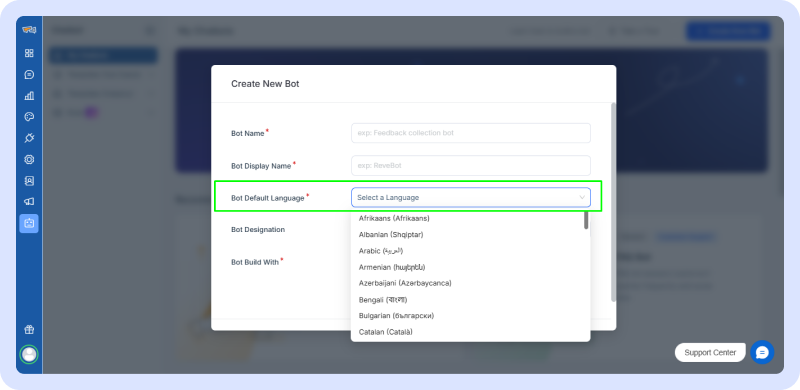
Step 04: Once inside the bot, you will get into the builder directly where you can build a bot using the visual flow builder. There is a tab called translate where you can configure your multilingual chatbot. Once you have build or at least developed a certain portion of your chatbot in your default language, you can then go to translation tab.
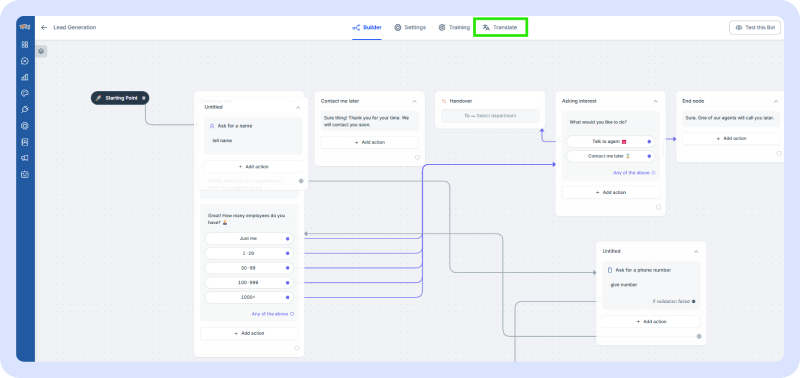
Step 05: When you go to the translation tab, you will land on the Translate page, where it can be seen that all the bot texts of all the actions are already available. To add a new language, click the Add Language button.
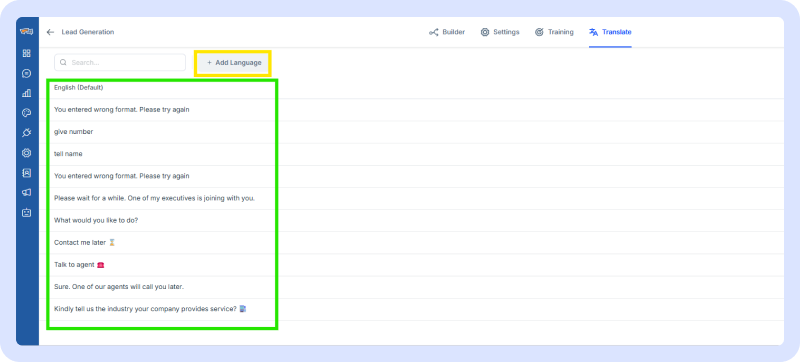
Step 06: A drop-down will appear, from where you need to select a language you want to translate. For example, you want to select Arabic. Then select Arabic & click Add & Translate. What will happen is that REVE chat will automatically translate the available bot texts into the selected language.
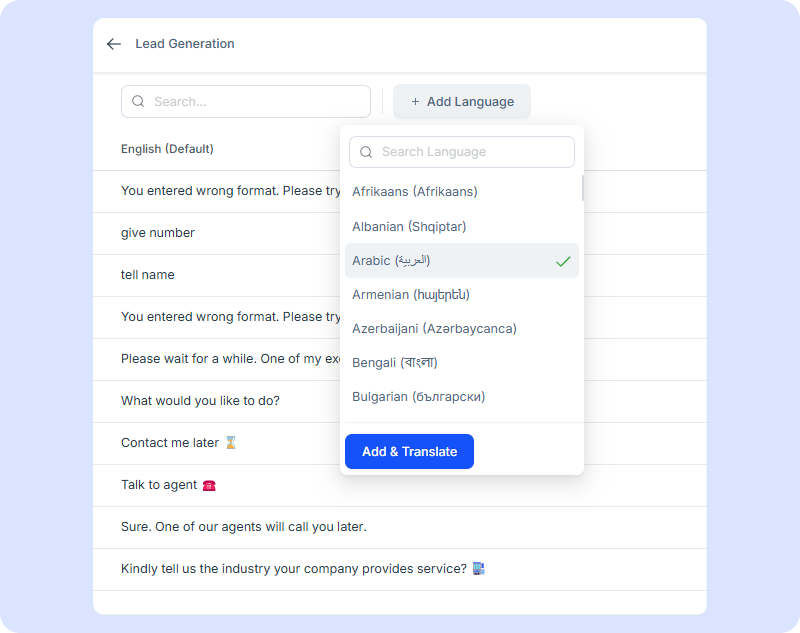
Step 07: If any of the auto translations are not accurate, you can click any translated text to modify the line.

Step 08: Finally, after adding new language(s), if more chatbot elements/nodes are added in the chatbot, then after you modify the chatbot, you just simply need to go back to the translate tab and refresh it once and those changes will be applied for other languages automatically.
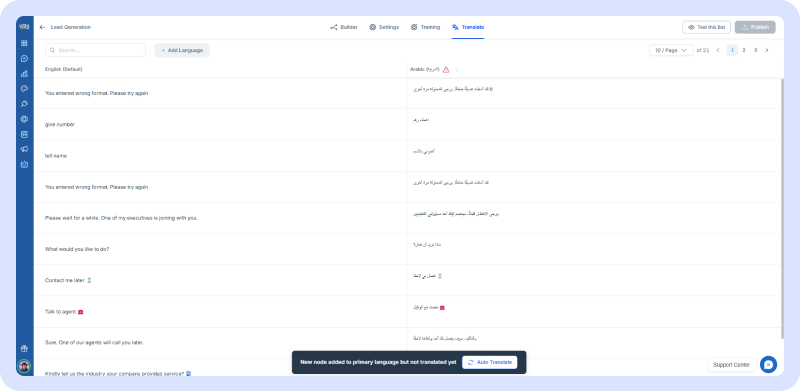
Please note: If you add for instance English as your default language but build the bot in another such as Spanish language in the bot builder then bot will not consider that. So make sure you select the default language carefully and build the main bot in that language.
Real-world Examples of Multilingual Chatbot
A multilingual chatbot can really set a company apart from those that aren’t using one. Let’s take a look at a few businesses that are successfully using multilingual chatbots to enhance their operations.
Veritas Finance Limited is working to provide financial support to micro, small, and medium enterprises (MSMEs) in India. This group has been underserved despite various efforts. The main goal of this company is to make it easier for individuals to access credit. They want to reach the rural areas.
The main challenge they faced was to reach these people in their language as rural people couldn’t talk or understand English effectively. They find the ultimate solution by implementing REVE multilingual chatbot for languages like Hindi, Bengali, English, Kannada, Tamil, Telugu, and more.
Since using the chatbot, Veritas has seen a 40% increase in customer interactions. They are now reaching people they couldn’t connect with before. Another example is-
One of the institutions of the Mexican Government, INAI which stands for Instituto Nacional de Transparencia, Acceso a la Información y Protección de Datos Personales (National Institute for Transparency, Access to Information, and Protection of Personal Data) has been using REVE’s multi-lingual chatbot.
INAI is Mexico’s autonomous body ensuring transparency, public access to government information, and personal data protection. It handles information requests, enforces privacy regulations, and promotes accountability to strengthen open governance and citizens’ rights.
To serve such cases to their citizen, INAI is using REVE Chat multi-lingual chatbot in both English and Spanish to cover all of the citizens of Mexico.
By using REVE Chats multi-lingual chatbot, INAI has been able to cover both Spanish and English-speaking audiences which otherwise would not have been possible. It has also improved their customer satisfaction by 45% as a result.
Challenges and Best Practices of Multilingual Chatbot
Dealing with language differences and cultural nuances is difficult. However, with the right strategies, these challenges are manageable. Let’s explore some best practices to make implementing a multilingual chatbot smoother and more effective.
1. Handling Linguistic Variations and Idioms
Different languages have unique idioms and cultural references that might not directly translate. Capturing these nuances accurately can be challenging.
Best Practices:
- Contextual Understanding: Invest in NLP models that focus on contextual understanding to interpret idiomatic expressions within different languages.
- Localization Teams: Collaborate with linguists or localization experts to ensure accurate translations that preserve cultural context.
2. Ensuring Accuracy and Quality
Maintaining translation accuracy while preserving the original intent across languages poses a significant challenge.
Best Practices:
- Human Review: Incorporate a review process involving bilingual experts to validate translations for accuracy, tone, and cultural sensitivity.
- Continuous Improvement: Implement feedback loops and regular updates to refine translations based on user interactions and linguistic data.
3. Scalability and Maintenance
As the number of supported languages increases, maintaining consistency and scalability becomes complex.
Best Practices:
- Automated Workflows: You no longer need to create language versions manually in the chatbot. With automation, simply select a language and publish it instantly.
- Modular Design: Create a modular architecture that allows for easy scalability and updates across all language variants.
4. User Experience
Providing a seamless and uniform user experience across languages can be challenging due to linguistic differences.
Best Practices:
- Multilingual User Testing: Conduct extensive user testing with native speakers of each supported language to ensure usability and cultural appropriateness.
- Adaptive Design: Design the chatbot interface to dynamically adapt to linguistic variations without compromising user experience.
5. Continuous Monitoring and Improvement
Chatbots need continuous monitoring and optimization to stay relevant and effective across multiple languages.
Best Practices:
- Analytics and Insights: Use tools to analyze user interactions in different languages. For instance, REVE Chatbot provides language-based insights and analytics, helping you identify areas for improvement and make informed updates.
- Agile Approach: Embrace an iterative approach to implement changes and enhancements based on user feedback and evolving linguistic trends
Bottom Line
The growing demand for instant service in customers’ preferred languages underscores an undeniable truth: businesses can no longer afford to overlook the transformative value of multilingual chatbots in delivering personalized, inclusive, and global customer experiences.
Multilingual chatbots, powered by advanced AI and large language models (LLMs) like GPT and LLAMA, seamlessly integrate natural language understanding with real-time translation to bridge communication gaps across languages and cultures.
These AI-driven solutions not only enhance customer support by providing 24/7 multilingual service but also enable businesses to cater to diverse audiences at scale, creating deeper connections and boosting engagement.
Now is the time for businesses to embrace multilingual AI solutions like REVE Chat’s cutting-edge platform, designed to break down language barriers, unlock global growth opportunities, and build lasting customer relationships.
By leveraging these innovative tools, companies can secure their place in an interconnected world and achieve long-term success in the global marketplace.
Frequently Asked Questions
A multilingual chatbot is a conversational AI tool that can communicate in multiple languages, enabling businesses to interact with customers globally without language barriers.
Yes, a chatbot can talk in different languages if it is built with multilingual capabilities or integrated with language translation technologies like NLP models.
Multilingual Natural Language Processing (NLP) refers to AI techniques that enable machines to understand, interpret, and respond in multiple languages. It powers multilingual chatbots to process diverse linguistic inputs accurately.
To create a multilingual chat you need to follow these steps:
1. Choose a chatbot platform with multilingual support.
2. Train the chatbot using datasets in the target languages.
3. Leverage NLP models for understanding and responding to text.
4. Test thoroughly for accuracy in each language.
5. Continuously update based on user feedback.
Multilingual Conversational AI is an advanced AI system designed to engage users in their preferred language, delivering seamless interactions across multiple languages via text or voice.
No, you don’t need to build a chatbot in all languages. With REVE Chat’s multilingual chatbot, you can easily support multiple languages based on your target audience. You can choose the languages that matter most to your customers, such as Hindi, Bengali, or Arabic, and provide seamless communication without the need for every language.
Yes, LLM (Large Language Models) is important for multilingual chatbots. REVE Chat leverages LLMs like GPT and LLAMA to ensure accurate and context-aware conversations in multiple languages.


